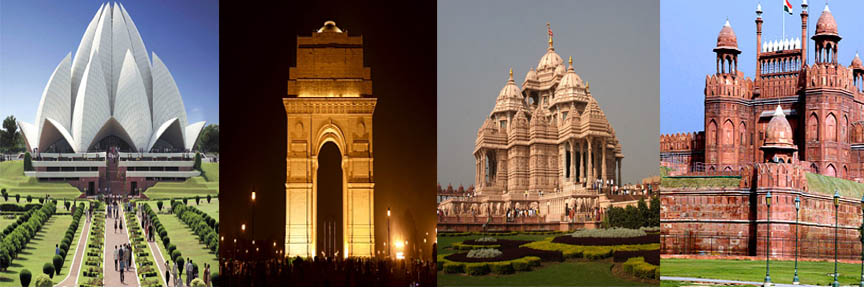
Delhi - A Historic City:
A capital city of great character, contrasts and convolutions - Delhi is a delicious cocktail. A city with antiquity that dates back over 2,000 years, it is also a modern metropolis with fast cars, neon lights and shopping malls. So varied are the shades of Delhi's different faces, it is difficult to grasp in a short span of time. Home to over 10 million people, Delhi emerges from the ruins of the seven historical cities built over time, to the central hub of commerce and government, onwards into the prosperous southern parts and the multitude of villages which have been engulfed by the ever-growing city.
Sightseeing in Delhi
There are plenty of sightseeing places in New Delhi. Popular for its art galleries, museums and archaeological sites, New Delhi offers a wide variety of sightseeing choices. Interested in history? Check out the various museums like National Museum, Indira Gandhi Memorial Museum, and crafts museum. You can also visit the famous Sulabh International Museum of Toilets.
Marvel at the ancient architectural delights like Humayun's Tomb, Jantar Mantar, Qutub Minar, and Bahai House of worship or Lotus Temple as it is known popularly.
India Gate
India Gate is one of the major tourist destinations in the Indian context. It was primarily built as a memorial to commemorate the 70,000 India soldiers killed in World War I it was designed by Sir Edwin Lutyens. As it is located on Rajpath, the road which leads to the magnificent Rashtrapati Bhawan, it is one of the most impressive places in Delhi.
Qutub Minar
Despite the controversial origins of Qutub Minar, one claiming that it signified the beginning of the Muslim rule in India while others saying a minaret to the muezzins, this monument is one of the most beautiful creations. It was the Qutab-ud-din Aibak who commenced the construction of the Qutab Minar in 1200 AD. The successor Iltutmush also added three more storeys with Firoz Shah Tughlak and others.
Red Fort
As the Red Fort is built with red coloured stone, it is one of the most magnificent palaces in the world. It was the Bhadur Shah Zafar who marked the end of the three century long Mughal rule. It was the Shah Jahan, the Mughal Emperor, decided to shift to Delhi and for the purpose laid the foundation stone of the Red Fort in 1618. It is good to note that this building comes with a circumference of almost one and a half miles with an irregular octagon having two entrances, the Lahore and Delhi Gates.
Humanyun's Tomb
As we know that Mughals used to love gardens much, the culture of fountains and water was the residual effect. Humanyu's Tomb is the first finest example of Mughal architecture in India. It was built by the emperor's grieving widow, Haji Begum, in 1565 AD. It was for the first time red sandstone was used in the building that marked the beginning of a new tradition of ornate style culminating in the Taj Mahal of Agra. It is designed by the Persian architect, Mirza Ghyas. The beauty is enhanced by the fact that it is located in the midst of a large square garden. As it is covered by high walls, it makes it the gateways to the south and west simply magnificent. Copper pinnacle tops the minaret.
Jantar Mantar
You could say that it is a gallery of modern art since this is what it appears at the first sight. Indeed an example of a modern art, this observatory is magnificent in every respect. It was the effort of Sawai Jia Singh II of Jaipur, 1699-1743, which made it possible for building the Jantar Mantar. Jantar Mantar constitutes the first of the five observatories built with large masonry instruments.
Jama Masjid
The mosque, Jama Masjid was started being constructed in the year 1650. It was the Mughal Emperor Shah Jahan who complemented his palace at the Red Fort. With more than 5,000 workers who worked for six years in order to complete the largest mosque in India toiled into the soil to make it happen. The emperor, every Friday, would be travelling in state from the fort and would attend the congressional prayers. Indeed Jama Masjid is one of the finest examples of Mughal architecture. With 408 square feet main courtyard, it is paved with red stone. One could attend the prayers in the centre.
Rajghat
Rajghat is recognized for the mortal remains of Mahatma Gandhi, the father of the Indian nation. It was in the evening of January 31, 1948 when Mahatma Gandhi was cremated. One could see the last words, 'Hey Ram' (Oh God) engraved in a garden with fountains and a variety of exotic trees.
Museums
Delhi also has a cluster of museums with some of the most valuable displays in the country.